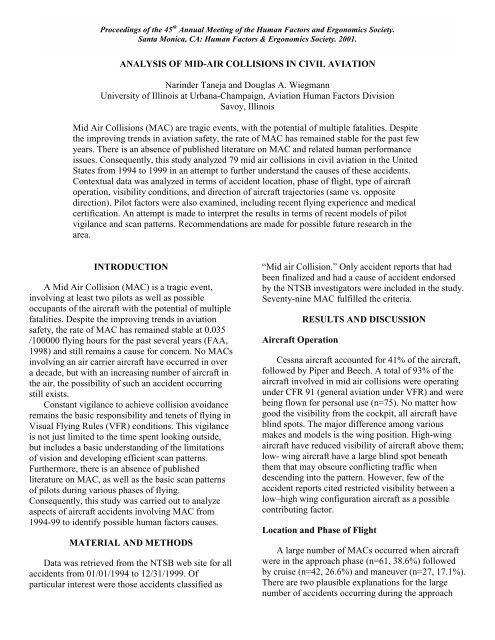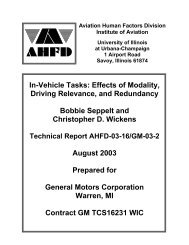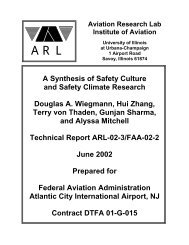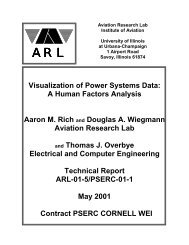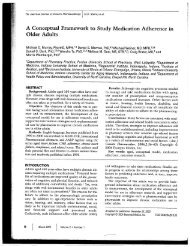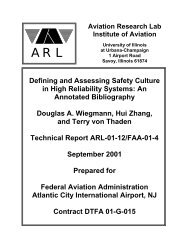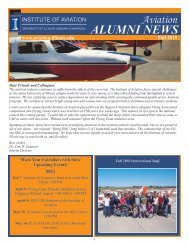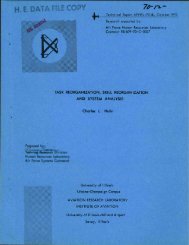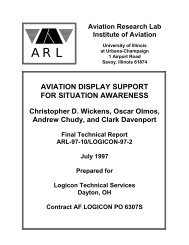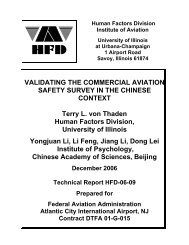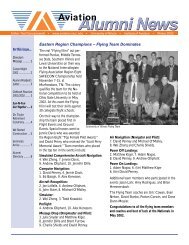ANALYSIS OF MID-AIR COLLISIONS IN CIVIL AVIATION Narinder ...
ANALYSIS OF MID-AIR COLLISIONS IN CIVIL AVIATION Narinder ...
ANALYSIS OF MID-AIR COLLISIONS IN CIVIL AVIATION Narinder ...
Create successful ePaper yourself
Turn your PDF publications into a flip-book with our unique Google optimized e-Paper software.
Proceedings of the 45 th Annual Meeting of the Human Factors and Ergonomics Society.Santa Monica, CA: Human Factors & Ergonomics Society. 2001.<strong>ANALYSIS</strong> <strong>OF</strong> <strong>MID</strong>-<strong>AIR</strong> <strong>COLLISIONS</strong> <strong>IN</strong> <strong>CIVIL</strong> <strong>AVIATION</strong><strong>Narinder</strong> Taneja and Douglas A. WiegmannUniversity of Illinois at Urbana-Champaign, Aviation Human Factors DivisionSavoy, IllinoisMid Air Collisions (MAC) are tragic events, with the potential of multiple fatalities. Despitethe improving trends in aviation safety, the rate of MAC has remained stable for the past fewyears. There is an absence of published literature on MAC and related human performanceissues. Consequently, this study analyzed 79 mid air collisions in civil aviation in the UnitedStates from 1994 to 1999 in an attempt to further understand the causes of these accidents.Contextual data was analyzed in terms of accident location, phase of flight, type of aircraftoperation, visibility conditions, and direction of aircraft trajectories (same vs. oppositedirection). Pilot factors were also examined, including recent flying experience and medicalcertification. An attempt is made to interpret the results in terms of recent models of pilotvigilance and scan patterns. Recommendations are made for possible future research in thearea.<strong>IN</strong>TRODUCTIONA Mid Air Collision (MAC) is a tragic event,involving at least two pilots as well as possibleoccupants of the aircraft with the potential of multiplefatalities. Despite the improving trends in aviationsafety, the rate of MAC has remained stable at 0.035/100000 flying hours for the past several years (FAA,1998) and still remains a cause for concern. No MACsinvolving an air carrier aircraft have occurred in overa decade, but with an increasing number of aircraft inthe air, the possibility of such an accident occurringstill exists.Constant vigilance to achieve collision avoidanceremains the basic responsibility and tenets of flying inVisual Flying Rules (VFR) conditions. This vigilanceis not just limited to the time spent looking outside,but includes a basic understanding of the limitationsof vision and developing efficient scan patterns.Furthermore, there is an absence of publishedliterature on MAC, as well as the basic scan patternsof pilots during various phases of flying.Consequently, this study was carried out to analyzeaspects of aircraft accidents involving MAC from1994-99 to identify possible human factors causes.MATERIAL AND METHODSData was retrieved from the NTSB web site for allaccidents from 01/01/1994 to 12/31/1999. Ofparticular interest were those accidents classified as“Mid air Collision.” Only accident reports that hadbeen finalized and had a cause of accident endorsedby the NTSB investigators were included in the study.Seventy-nine MAC fulfilled the criteria.Aircraft OperationRESULTS AND DISCUSSIONCessna aircraft accounted for 41% of the aircraft,followed by Piper and Beech. A total of 93% of theaircraft involved in mid air collisions were operatingunder CFR 91 (general aviation under VFR) and werebeing flown for personal use (n=75). No matter howgood the visibility from the cockpit, all aircraft haveblind spots. The major difference among variousmakes and models is the wing position. High-wingaircraft have reduced visibility of aircraft above them;low- wing aircraft have a large blind spot beneaththem that may obscure conflicting traffic whendescending into the pattern. However, few of theaccident reports cited restricted visibility between alow–high wing configuration aircraft as a possiblecontributing factor.Location and Phase of FlightA large number of MACs occurred when aircraftwere in the approach phase (n=61, 38.6%) followedby cruise (n=42, 26.6%) and maneuver (n=27, 17.1%).There are two plausible explanations for the largenumber of accidents occurring during the approach
phase. Firstly, approach and landing is considered astressful portion demanding aviation skills of thehighest order to process information both from theinstrument panel as well as the outside world, besidescommunicating with the air traffic control. Secondly,given the small funnel of airspace planes occupyduring the landing, any confusion about who’s landingin what order, and where they are, can often lead toMACs.MAC occurring during cruise are surprising,because without the distractions created by arrival anddeparture, cruise is the phase of flight when pilotshave the most time to look for traffic. But, it is thealso the longest phase of flight and the time forgreatest complacency. According to the NTSB, onecommon thread links the majority of these accidents:inattention on the part of the crews of both aircraft(Air Safety Foundation, 2001). MAC whilemaneuvering in the traffic pattern may occur as aresult of improper or misunderstood position reports,or erroneous assumptions. This is particularly true atnon-towered airports.Although 73% of the MAC occurred away fromthe airport, it was seen that majority of them werewithin 3 miles from the airport. Most of the approachaccidents occurred on non-towered airports.Information from the narrative revealed that all MACoccurred below 6000 feet, with 50% below 1000 feetaltitude. The FAA also specifies that traffic tends tocongest around regulatory airspace borders, or aroundthe airports where GA aircraft flying under VFR tendto circumnavigate, awaiting clearance to enter (FAA,1989).Direction of TravelInformation from the narrative was used toclassify MAC based on the direction of travel at thetime of accident. Approximately, 35.4% of the MACinvolved aircraft traveling in opposite (head on)direction, whereas the rest of them involved aircrafttraveling generally in converging directions. Manysuch accidents result from a faster aircraft overtakingand hitting a slower moving airplane.Visibility ConditionsMeteorological conditions had almost no role toplay, with all the MAC occurring under VMCconditions; all but 4 MAC occurred with visibilitymore than 5 miles. Majority of the MAC occurredduring the daylight hours. These findings reconfirmthe recommendations of the FAA on the subject thatextra vigilance should be adopted when flying in goodweather with miles of visibility (FAA, 2001). Zellermentions that 80% of the MAC in the Air Forceoccurred in daylight, good weather VFR conditions(Zeller, 1959). Atmospheric conditions in the form ofhaze and sun glare were mentioned in 12 cases, bothof which can affect target visibility.Accident SeverityAlmost 50% of the aircraft were destroyed,maximum damage occurring when they were in thecruise phase. Similarly, 45% of the MAC involvedfatalities and there were increased fatalities amongpilots (67%) during the cruise phase of flight. Thelowest percentage of fatalities occurred in MACsoccurring during the approach/landing phase. Thisappears to be a function of aircraft speed (cruise speed> approach/landing speed) and the altitude (cruisealtitude > approach/landing altitude).Pilot InformationThe majority of the pilots involved were holding aPPL/CPL license and a Class II/III medical certificate.However, half of pilots had certificates with anendorsement of a medical waiver, the details of whichwere not available. Data on the age of the pilots wasalso not available in the NTSB reports.There were two peaks in terms of experience.Approximately, 38% of the pilots had less than 1000hours of total flying experience, whereas 25% hadmore than 5000 hours. Flying experience on typeparallels this finding. These findings suggest thatMACs may not be simply due to either a lack ofskill/experience or the onset of complacency due toseasoned experience.Indeed, the majority of the pilots had not flown inthe last 24 hours (n=83, 52.5%) and even in the 30days (n=60, 38%) preceding the MAC. This findingraises the question of how much flying is goodenough to maintain proficiency? In the military, it iscustomary for a pilot to undergo a check ride/refresherflying after a period of lay off (say one monthleave/absence from flying). The basis being thatcertain skilled activities do need to be refreshed,despite prior experience, after a period of nonengagement.
NTSB Cause FactorsWhy then do MACs occur in conditions so idealfor flying? The answer to this question is obvious bothto a layman as well as the learned investigator:inadequate look out by the pilot/pilots. A total of 85%(n= 67) MAC accidents involved inadequate lookoutby one pilot as a cause.The NTSB in its report on the 1956 MAC over theGrand Canyon probably sums up this finding foralmost all the MAC: “the pilots did not see each otherin time to avoid collision. Evidence suggest that itresulted from any one or a combination of thefollowing factors: intervening clouds, visuallimitations due to cockpit visibility, preoccupationwith normal cockpit duties, preoccupation withmatters unrelated to cockpit duties …(and)physiological limits to human vision reducing the timeand opportunity to see and avoid the otheraircraft”(Air Safety Foundation, 2001).GENERAL DISCUSSIONThe rules for maintaining separation from otheraircraft in VFR conditions are spelled out in FAR91.113: “when weather conditions permit, regardlessof whether an operation is conducted under instrumentflight rules or visual flight rules, vigilance shall bemaintained by each person operating an aircraft so asto see and avoid other aircraft” (Air SafetyFoundation, 2001). “See and avoid “ is the commonterminology for this method of collision avoidance.Vision is the most important tool pilots have to“see and avoid” other aircraft. The key factors thoughare the total time and the nature of scans the pilot usesin scanning the outside world looking for otheraircraft. The FAA in their aeronautical informationmanual advice airmen about the measures that help inavoiding mid air collisions, besides others, whichwould help them in safe flights (FAA, 2001). It issuggested that the time a pilot spends on visual tasksinside the cabin should represent no more that 1 / 4 to 1 / 3of the scan time outside, or no more than 4 to 5seconds on the instrument panel for every 16 secondsoutside. Since the brain is already trained to processsight information that is presented from left to right,one may find it easier to start scanning over the leftshoulder and proceed across the windshield to theright.Wickens, Xu, Helleberg, Carbonari, and Marsh(2000) discussed several interesting features aboutpilot scanning behaviors/patterns, which could largelyexplain the findings of this study. Using eye trackingdevices to track pilots eye movements while flying asimulator with real-world cockpit views, they foundthat the pilots spent approximately 37% of their timeattending to the outside world, a value that contrastssharply with the FAA recommended figure ofapproximately 75%. The results also indicate that thedwells (time spent on an area of interest) weresignificantly longer on the Instrument panel (6.6 secwith a maximum of 18 sec) than on the outside world(OW) (2.9 sec). This finding could explain to a largeextent the implication of ‘inadequate’ in the causationof MAC and calls for further research on the basicscan pattern requirements to avoid MAC.Wickens et al. (2000) have also proposed a modelof change detection. They propose that fourdeterminants influence change detection (targetdetection on appearance in the field of view). Firstly,the salience of the target. The next factor influencingtarget detection is the expectancy of finding a target,implying that a cue given by some means about thetarget would enable detection earlier then otherwise.Thirdly, the probability of detecting a target would bethe value placed on detection. If a pilot were himselfresponsible for detection and avoiding traffic, morevalue would be assigned to this task compared to thesituation when the pilot is totally under the ATC. Thefourth factor is the effort or workload of maneuveringinvolved in detection and avoidance.Applying this model to the MAC data may helpfurther explain the findings. During cruise, whengeneral aviation pilots are not under the control ofATC, they are in unregulated airspace at low altitudewith many other similar aircraft (hence the targetexpectancy and detection value should be higher). Inturn, the workload cost should be low, because duringcruise the outside world provides a lot of informationwith regards to navigation. Yet, MACs have occurredin a large number during this phase. Therefore,according to the model, MACs during cruise are likelyto be due to the issue of saliency. The eyes duringcruise accommodate at a finite distance (a known fact)in the absence of visual cues and it may require adeliberate attempt to re-accommodate the eyes in anattempt to look for far off targets, and hence thedelayed reaction in detection.
Another large portion of MAC accidents occurredduring the approach and landing phases of flight.Based on the above model, it would seem reasonableto assume that pilots would be more vigilant to detectaircraft near the vicinity of an airport, both because ofthe likelihood (expectancy) of encountering one andthe increased incidence of a MAC near an airport. Thesaliency of other aircraft would also be high, due tothe closeness within the airspace. Value may also behigh, if the airport does not have an ATC tower.However, these factors may be counteracted by thehigh workload during approach and landing, whereinscanning of instruments to maintain various criticalflight parameters, as well as communicating intentionsto other aircraft in the area is required. Currency inflying will influence the amount of workload a pilotperceives, age and any medical fitness will also play apart. Indeed, the majority of the MACs involved pilotsthat had very little recent flight time prior to theaccident.The other factor in detection and perception oftargets is that of prior experience of similar situations.It is postulated that a pilot once having gone throughthe images of a near mid air collision approachingfrom distance, would have a mental representation ofwhat a target on collision course looks like, thusmaking detection much easier and faster. This issuealso relates to the concept of ‘priming’, which refersto a change in the ability to identify an item as aconsequence of a specific prior encounter (Schacter &Badgaiyan, 2001). If this hypothesis is validated byfuture studies, it could have far reaching implicationsin reducing MACs by being incorporated in flyingtraining syllabi.Age and experience needs to be tested on all theseissues so that realistic data could be generated. A goodstarting point would be the analysis of pilot incommand characteristics in terms of age, experienceand medical waivers and MAC.RECOMMENDATIONSThere is a need to develop a model of adequatelookout for the pilot. This should include documentingand studying scan patterns of pilots, the time spentinside/and outside the cockpit under all phases offlight and how they compare with current FAArecommendations on the subject.It may be interesting to study the effect ofexposure of the pilots to a simulated near mid aircollision on a simulator/PC device. If researchvalidates the hypothesis that a simulated experience ofnear mid air collision can lead to an early detection oftargets, it could have far reaching trainingimplications.
REFERENCESAir Safety Foundation (2001). Collision avoidance:Strategies and tactics. Safety Advisor, Operationsand Proficiency, 4.FAA. (1989). FAA’s interim actions to reduce nearmid air collisions (GAO/RCED/89-149).Washington, DC: Federal AviationAdministration.FAA. (1998). Aviation system indicators annualreport. Washington, DC: Federal AviationAdministration.FAA. (2001). Federal aviation regulations andaeronautical information manual: Medical factsfor pilots: judgment aspects of collision avoidance(Chapter 8-1-8). Newcastle, WA: AviationSupplies & Academics.Schacter, D.L., & Badgaiyan, R. D. (2001).Neuroimaging of priming: New perspectives onimplicit and explicit memory. Current Directionsin Psychological Science, 10(1), 1-4.Wickens, C. D., Xu, X., Helleberg, J. R., Carbonari,R., & Marsh, R. (2000). The allocation of visualattention for aircraft traffic monitoring andavoidance: Baseline measures and implicationsfor freeflight (Technical Report ARL–00-2/FAA-00-2). Savoy, IL: University of Illinois, AviationResearch Lab.Zeller, A. F. (1959). Human aspects of mid-aircollision prevention. Aerospace Medicine; 8, 551-60.


